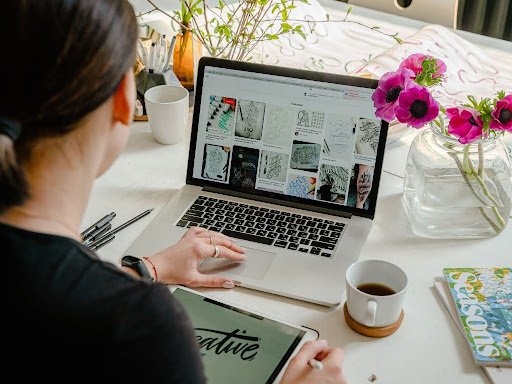In today’s world, standing out as a professional, coach, or entrepreneur is harder than ever. Artificial Intelligence (AI) is everywhere—it writes, designs, edits, and even speaks. While this opens up opportunities, it also creates sameness. So how do you build a personal brand that feels unique, trustworthy, and future-ready?
The answer lies in Design Thinking for Personal Branding. This approach focuses on human connection, creativity, and problem-solving—qualities that AI cannot replace.
In this blog, we will explore how design thinking works for personal branding, why it’s essential in the AI era, and practical steps you can take to build your brand.
What is Design Thinking for Personal Branding?
The Basics of Design Thinking for Personal Branding
Design thinking is a structured yet flexible process for solving problems. Instead of jumping to solutions, it first looks at people’s needs. Applied to branding, this means you don’t just create a logo or tagline—you build an identity based on empathy and value.
Design Thinking for Personal Branding helps you:
- Understand what your audience truly wants
- Communicate your unique strengths
- Create brand experiments and refine them
- Stay authentic in a world full of AI noise
Why Personal Branding Needs Design Thinking in the Digital Age
In the digital era, personal branding is no longer just about self-promotion. People want connection, meaning, and trust. By using design thinking, you make your brand audience-focused instead of ego-focused. This makes your brand stronger and more relatable.
Why Personal Branding Needs a Fresh Approach in the AI Era
Challenges of Building a Personal Brand in the AI Era
AI has brought many advantages, but it also creates challenges:
- Content Overload: Millions of AI-generated posts make it hard to be seen.
- Trust Gap: People doubt whether content is human or machine-made.
- Changing Skills: Professionals need to show adaptability and emotional intelligence, not just technical skills.
How AI Impacts Traditional Branding Methods
Traditional branding relied on visuals, slogans, and repetition. Now, AI can generate these in seconds. What AI cannot create is human authenticity. This is why Design Thinking for Personal Branding is vital—it adds the human element back into branding.
The Five Stages of Design Thinking for Personal Branding

Stage 1: Empathize – Understanding Your Audience and Yourself
Ask yourself:
- Who is my audience?
- What problems do they face?
- What do they expect from someone like me?
Empathy also means self-awareness. You must understand your own story, strengths, and motivations.
Stage 2: Define – Framing Your Brand Problem Clearly
A personal brand without clarity feels lost. Instead of saying, “I need a brand,” define it as:
- “How can I position myself as a thought leader in my field?”
- “How can I balance AI efficiency with my human values?”
Stage 3: Ideate – Exploring Creative Brand Possibilities
At this stage, brainstorm without limits. For example:
- Share your expertise through storytelling videos.
- Blend AI tools with human coaching.
- Create workshops that show your unique perspective.
Stage 4: Prototype – Building and Testing Brand Experiments
Create small, testable versions of your brand identity:
- A short LinkedIn post sharing your story
- A sample video explaining your expertise
- A redesigned personal website homepage
Stage 5: Test – Refining Your Personal Brand with Feedback
Gather feedback from your network. Look at engagement numbers, comments, and conversations. Use that feedback to refine your message and approach.
How AI and Design Thinking Work Together in Personal Branding
Using AI Tools Without Losing Human Authenticity
AI is useful for research, automation, and content support. But it should never replace your voice. Use AI for efficiency, but always add your story, values, and emotions.
Balancing Automation with Human Connection
- Automate repetitive tasks (like scheduling posts).
- Personalize key interactions (like responding to comments or emails).
This balance ensures your brand feels human in an AI-powered world.
The Importance of Storytelling in Personal Branding
How Stories Build Trust in the AI Era
Stories are powerful because they show struggle, growth, and humanity. In a world full of machine-written content, your personal stories build credibility and trust.
Storytelling Techniques with Design Thinking for Personal Branding
- Share real challenges and how you overcame them.
- Use case studies from your clients or projects.
- Keep stories short, relatable, and emotionally engaging.
The Role of Systems Thinking in Personal Branding
Seeing Your Brand as a Connected Ecosystem
Your personal brand is not one thing—it’s a system of parts:
- Your expertise
- Your online presence
- Your network connections
- Your values and actions
Aligning Skills, Presence, and Audience Engagement
When these parts work together, your brand feels strong and consistent. If one part is weak (for example, poor audience engagement), the whole brand suffers. Systems thinking ensures balance.
Practical Steps to Apply Design Thinking for Personal Branding
Step 1: Conduct a Personal Brand Audit
- What do people already think of you?
- What skills or values do you want to highlight?
- Does your online presence match your real identity?
Step 2: Research and Understand Your Audience
- Who do you want to attract—clients, employers, or followers?
- What problems do they face daily?
Step 3: Craft a Clear and Human-Centered Brand Message
Write a one-line statement about what you stand for. Example:
“I help professionals embrace AI tools while staying human-centered.”
Step 4: Experiment with AI-Supported Branding Formats
- Blog posts supported by AI research but written in your tone
- Short video content with your personal story
- Infographics that simplify your insights
Step 5: Collect Feedback and Adapt Continuously
Keep testing your ideas. Your personal brand is not fixed—it grows as you do.
Common Mistakes to Avoid in AI-Driven Personal Branding
Overusing AI Tools Without Personalization
If everything sounds machine-made, people won’t trust your brand. Add personal touches to every piece of content.
Ignoring Feedback and Authentic Engagement
Don’t just push out content. Listen, respond, and adapt. Engagement builds trust faster than polished visuals.
Why Design Thinking for Personal Branding Works
Human-Centered Approach That Builds Trust
Audiences want connection, not perfection. Design thinking makes empathy the foundation of your brand.
Creativity and Adaptability in the AI Era
Since AI trends change quickly, adaptability is crucial. Design thinking gives you the tools to stay flexible while keeping your brand authentic.
Case Studies: Personal Branding with Design Thinking
Case Study 1: A Tech Coach Using AI and Empathy
Inspired by thought leaders like Sundar Pichai and Deepak Chopra, a modern tech coach combined AI-based insights with personal coaching stories to build her brand. Her message became:
“Helping professionals grow careers with AI and empathy.”
By blending the analytical clarity often seen in Sundar Pichai’s approach to technology with Deepak Chopra’s focus on emotional intelligence, she created a brand that felt both futuristic and deeply human. This mix of tech and empathy attracted working professionals seeking meaningful career growth.
Case Study 2: An Entrepreneur Blending Storytelling with AI
Taking cues from innovators like Anand Mahindra and Tanmay Bhat, a startup founder crafted his brand around transparency and technology. He shared honest stories of failure, resilience, and learning, while using AI tools to test and refine his content.
His openness made him relatable—much like Mahindra’s authentic presence on social media—while his data-driven creativity mirrored Tanmay’s forward-thinking use of digital platforms. The result was a powerful personal brand that positioned him as both authentic and future-ready.
The Future of Personal Branding in the AI Era
 Emerging Trends in AI and Personal Branding
Emerging Trends in AI and Personal Branding
- AI avatars and assistants will support personal brands.
- Audiences will value “proof of humanity” in branding.
- Hybrid content (AI + human touch) will become the norm.
Why Authenticity Will Remain the Key to Success
Technology will change, but authenticity never goes out of style. People will always trust real human stories over polished AI scripts.
Conclusion
AI is transforming how we build and present personal brands. But while AI can automate, analyze, and create, it cannot replace human authenticity.
That’s why Design Thinking for Personal Branding is so powerful. It helps you create a brand that is empathetic, creative, and adaptable—qualities that will always set you apart.
Your brand is not just about visibility—it’s about impact. Design thinking ensures that impact lasts.
About the author
 Anuradha is a passionate Design Thinking practitioner with 10+ years of industry experience. She has dived into the field of Design and Design Thinking, where she is trained to design experiences. She is the Founding Partner and Design Lead at Humane Design and Innovation (HDI) Consulting. Her professional career spans various roles in Advisory, UX Design, Service Design, Engineering Design, Design Integration, and Training. She was the lead designer of the Design Thinking and Innovation practice at KPMG. She has designed multiple digital experiences by conducting strategic UX workshops and design experiences that add functional and emotional value. To her friends & peers, she is the Bonding Agent of the team and always a go-to person. She is an avid reader, blogger & painting enthusiast.
Anuradha is a passionate Design Thinking practitioner with 10+ years of industry experience. She has dived into the field of Design and Design Thinking, where she is trained to design experiences. She is the Founding Partner and Design Lead at Humane Design and Innovation (HDI) Consulting. Her professional career spans various roles in Advisory, UX Design, Service Design, Engineering Design, Design Integration, and Training. She was the lead designer of the Design Thinking and Innovation practice at KPMG. She has designed multiple digital experiences by conducting strategic UX workshops and design experiences that add functional and emotional value. To her friends & peers, she is the Bonding Agent of the team and always a go-to person. She is an avid reader, blogger & painting enthusiast.
We at Humane Design strongly believe in the human ethos and draw inspiration from humans and other elements of nature to design innovative solutions for organizations of all sizes. We will be glad to be your success partner. Please email us your requirements at explore@humaned.in.
Want to future-proof your brand? Book a personal brand audit today.
FAQs on Design Thinking for Personal Branding in the AI Era
What is the main benefit of Design Thinking for Personal Branding in the AI Era?
It creates a brand that is authentic, audience-focused, and adaptable in the AI era.
Can AI replace personal branding?
No. AI can support tasks, but personal branding relies on human values, stories, and emotional connections.
How do I start applying design thinking to my personal brand?
Begin with empathy—understand your audience and your own strengths. Then test and refine small brand experiments.
Is Design Thinking for Personal Branding only for entrepreneurs?
No. It is useful for professionals, coaches, creators, and leaders in any industry.
How often should I update my personal brand?
At least once a year—or whenever your career, skills, or industry trends shift significantly.



